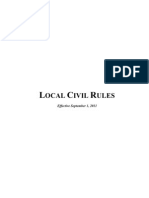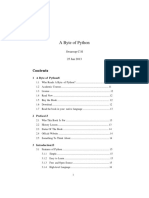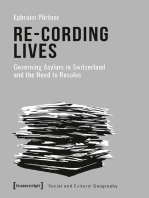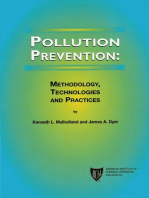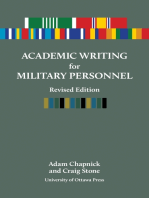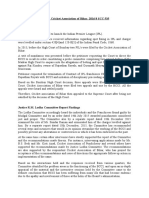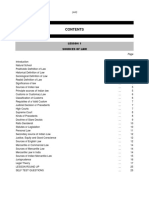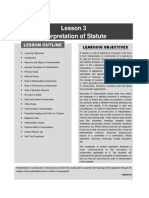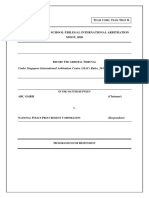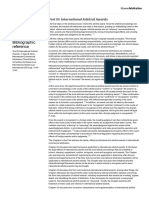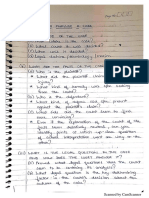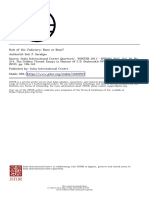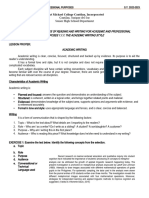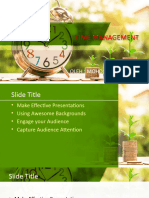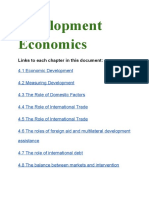XV NLSTIAM-Rules
XV NLSTIAM-Rules
Uploaded by
KHUSHBOO SHARMACopyright:
Available Formats
XV NLSTIAM-Rules
XV NLSTIAM-Rules
Uploaded by
KHUSHBOO SHARMACopyright
Available Formats
Share this document
Did you find this document useful?
Is this content inappropriate?
Copyright:
Available Formats
XV NLSTIAM-Rules
XV NLSTIAM-Rules
Uploaded by
KHUSHBOO SHARMACopyright:
Available Formats
TABLE OF CONTENTS
1. Definitions...................................................................................................................... 4
2. Interpretation .................................................................................................................. 6
3. Key Dates ....................................................................................................................... 6
4. Eligibility ....................................................................................................................... 7
5. Team Composition ......................................................................................................... 7
6. Assistance To Teams From Non-Members And/ Or External Sources ......................... 8
7. Registration .................................................................................................................... 8
7.1. General..................................................................................................................... 8
7.2. Registration Fee ....................................................................................................... 8
7.3. Payment of Registration Fee.................................................................................... 8
8. Clarifications to the Problem ......................................................................................... 9
9. Anonymity of Teams ..................................................................................................... 9
10. Memoranda .................................................................................................................. 10
10.1. General .................................................................................................................... 10
10.2 Rights Over Memoranda .................................................................................... 10
10.3 Submission of Memoranda ................................................................................ 10
10.3.1. Submission of Soft Copies ......................................................................... 10
10.4 Format of Memoranda ....................................................................................... 10
10.4.1. Memorandum Structure .............................................................................. 10
10.4.2. Font and Spacing ........................................................................................ 11
10.4.3. Penalties ...................................................................................................... 11
10.4.4. Cover Page .................................................................................................. 11
10.4.5. Table of Abbreviations ............................................................................... 12
10.4.6. Index of Authorities .................................................................................... 12
10.4.7. Statement of Facts ...................................................................................... 12
10.4.8. Issues Raised............................................................................................... 12
10.4.9. Arguments Advanced & Prayer .................................................................. 12
10.4.10. Footnotes and Citations .............................................................................. 12
11. Judging Of Memoranda ............................................................................................... 13
NATIONAL LAW SCHOOL OF INDIA UNIVERSITY, BANGALORE || PAGE 2 OF 22
11.1 General ............................................................................................................... 13
11.2 Substantive Scoring ........................................................................................... 13
11.3 Memorandum Penalties (Objective Deductions) ............................................... 13
11.4 Penalties for Objective Deductions .................................................................... 14
12. Qualification For Oral Rounds..................................................................................... 15
13. Oral Rounds ................................................................................................................. 15
13.1 General ............................................................................................................... 15
13.2 Order of Presentation ......................................................................................... 16
13.3 Time Allocation ................................................................................................. 16
13.4 Rebuttal and Sur-Rebuttal .................................................................................. 17
13.5 Communication During Oral Rounds ................................................................ 17
13.5.1. Oral ............................................................................................................. 17
13.5.2. Written ........................................................................................................ 18
13.6 Observing Oral Rounds...................................................................................... 18
13.6.1. Participants ................................................................................................. 18
13.6.2. Non-Participants ......................................................................................... 18
13.7 Determining Sides in advanced rounds.............................................................. 19
14. Judging Of Oral Rounds .............................................................................................. 19
15. Competition Format And Procedure ............................................................................ 19
15.1 General ............................................................................................................... 19
15.2 Preliminary Rounds ........................................................................................... 20
15.3 Qualification for Advanced Rounds .................................................................. 21
15.4 Advanced Rounds .............................................................................................. 21
15.4.1. Quarter Final Rounds.................................................................................. 21
15.4.2. Semi Final Round ....................................................................................... 22
15.4.3. Final Round ................................................................................................ 22
16. Prizes and Awards........................................................................................................ 22
NATIONAL LAW SCHOOL OF INDIA UNIVERSITY, BANGALORE || PAGE 3 OF 22
XV NLSTIAM RULES
These are the rules for the XV NLS-Trilegal International Arbitration Moot. The Rules of the
Moot are reviewed annually and are subject to change. Reliance on any past Rules or practice
will not in itself be an acceptable excuse for the failure to comply with the rules of the current
Moot.
1. DEFINITIONS
1.1 “Administrator(s)” means the Moot Court Society of the National Law School of
India University, Bangalore, members thereof, or any person/persons appointed for the
administration and conduct of the Competition, by the said Moot Court Society.
1.2 “Advanced Round” means the Final Round, Semi-Final Rounds and Quarter-Final
Rounds of the Competition.
1.3 “Bench Memorandum” means the memorandum of law, issues and authorities
concerning the competition problem prepared by the Authors/Administrator.
1.4 “Claimant” means the side that argues on behalf of the Claimant at any given point in
the competition.
1.5 “Clarifications” refer to procedural order(s) and/or any clarification(s) issued by the
administrator and published on the official website of the moot pursuant to Rule 7.
1.6 “Competition” means the XV NLS-Trilegal International Arbitration Moot, 2022.
1.7 “IST” means Indian Standard Time.
1.8 “Memorial” means the written arguments submitted by each team, submitted
according to these Rules.
1.9 “Speaker” refers to a participant who presents oral arguments in any given round.
1.10 “Official Website” means the website of the competition (www.nlstiam.in)
1.11 “Oral Round” means a team’s pleadings, comprising two speakers, submitted orally
in front of arbitrators, acting as adjudicators, on behalf of one of the parties against another
team representing the opposing party.
1.12 “Participant” refers to any member of an institution participating in the competition.
1.13 “Penalty” refers to the deductions imposed on the memorandum scores of a
participating institution, as provided for under Rule 10.3.
1.14 “Plagiarism”– If, in the memorandum checker’s opinion, there is found to be an
instance of plagiarism prevalent in a certain memorandum, the participating institution alleged
to have committed plagiarism will be asked to show cause by the administrators. If found guilty
NATIONAL LAW SCHOOL OF INDIA UNIVERSITY, BANGALORE || PAGE 4 OF 22
of plagiarism, the administrators may impose any sanction that it may deem fit, including
disqualification from the Moot.
In instances where the participating institution is alleged to have plagiarized from the
memorandum of another participating university memorandum, the latter will also be asked to
show cause by the administrators. If, in the opinion of the administrators, the latter has willingly
allowed the former to plagiarize from their work, such a participating institution shall also be
held guilty of plagiarism and sanctioned by the administrators as they deem fit.
The administrators define plagiarism as including the following:
1. Direct duplication of the work of somebody else’s work represented inter alia in books,
articles, internet sources without acknowledgement.
2. Substantial duplication of somebody else’s work represented inter alia in books,
articles, and internet sources without acknowledgement. This would include work
where sentences have been substantially copied, that is, where at the least seven
continuous words from the original work are present in the impugned memorandum
and/or where a segment of the impugned
3. Direct or substantial duplication of another moot memorandum, irrespective of whether
that memorandum is a competing memorandum or not, and irrespective of whether
there is acknowledgement or not. Substantial duplication denotes situations wherein
sentences have been substantially copied, that is, where at the least seven continuous
words from the original work are present in the impugned memorandum and/or where
a segment of the impugned memorandum has been paraphrased from the other
memorandum with minor changes, keeping intact the import of the latter.
1.15 “Preliminary Rounds” means the oral rounds which take place before the advanced
round, as defined under Rule 1.2, and for the purpose of determining which teams qualify for
the advanced rounds.
1.16 “Problem” means the official hypothetical Case- Study of the Competition released by
the administrators. Clarifications as defined under Rule 1.5 shall form part of the problem.
1.17 “Rebuttals” refer to the arguments presented by the Claimant in response to the
Respondent’s submissions at the end of the main pleadings of all the speakers.
1.18 “Respondent” means the side that argues on behalf of the Respondent at any given
point in the competition.
1.19 “Scouting” means a person observing the Oral Rounds of a team other than the team
such person is associated with.
NATIONAL LAW SCHOOL OF INDIA UNIVERSITY, BANGALORE || PAGE 5 OF 22
1.20 “Surrebuttal” refer to the defense presented by the Respondent to the rebuttals as
defined in Clause 1.15.
1.21 “Team Code” refers to the code allocated to a participating institution by the
administrator after completion of the Registration according to Rule 6.4.
1.22 “Tribunal” means a collective reference to the arbitrators present at the oral round,
where an “arbitrator” is an adjudicator of an oral round.
1.23 “Video Conference” refers to the video call on the specified platform, the details of
which will be specified at a later point of time according to Rule 13.5.1.d.
2. INTERPRETATION
The administrators will have exclusive authority to interpret the Rules in the interest of fairness
and equality. The interpretation placed upon these Rules by the administrators shall be
conclusive and the decision of the administrators regarding the application of these Rules shall
be final.
3. KEY DATES
3.1. The following key dates shall be adhered to:
Last Date for Registration- Indian Teams: March 15, 2022
Last Date for Registration- International Teams: March 25, 2022 (GMT)
Last Date for Sending Clarifications: March 1, 2022
Last Date for Submission of Memoranda: April 14, 2022
Release of Memorial Qualifier Results: May 9, 2022
Date of Oral Rounds: May 26 – May 29, 2022.
3.2. Unless specified otherwise, the dates mentioned shall refer to 11:59 PM (Indian Standard
Time/IST) on that date. For e.g., the last date for registering is March 15, 2022 which shall be
interpreted as March 15, 2022, 11:59 PM (IST).
3.3. The administrators retain the authority to change the deadlines for any individual team,
save for the deadline for submission of memoranda. The memorandum submission deadline
shall NOT be extended for any individual team.
NATIONAL LAW SCHOOL OF INDIA UNIVERSITY, BANGALORE || PAGE 6 OF 22
4. ELIGIBILITY
4.1. The Competition is open to all students, enrolled bonafide on a regular basis in an
Undergraduate/Post Graduate law course (including LL.M. programs) or its equivalent
conducted by any recognized institution.
4.1.1 A recognized institution shall be entitled to send only one team to the competition,
whether from the Undergraduate or Post Graduate law course, or a mixed team.
4.1.2 In a system where a university has constituent colleges, each college can register a team
or the university as such can be represented by a team comprising students from different
constituent colleges.
5. TEAM COMPOSITION
5.1. A team can have a minimum of two members and a maximum of four members. In
each of the oral rounds two members of the team will be speakers. Other members of the
team shall not aid them during the presentation of arguments in any way whatsoever.
Different members of the team can be speakers in different oral rounds. However, to be
eligible for the award for Best Individual Speaker mentioned in Rule 15.3, a participant
must have argued at least once for the Claimant and once for the Respondent during the
preliminary rounds. The average score per argument will be calculated and the award will
be determined on that basis.
5.2. Once registered, a team will not be permitted to vary the composition of the team in
any manner. Changes, if any, may only be made with the express permission of the
administrators (at their discretion), if due reason is shown for the same.
5.3. Any changes with respect to the contact details shall be notified to the administrators
with immediate effect. This obligation to inform shall continue throughout the course of the
Competition
5.4. Certificates for participating team members will be prepared from the team lists
submitted. The certificates of participation will show the names of the team members exactly
as they have been submitted. It is therefore incumbent on teams to ensure that names are spelled
and presented correctly.
NATIONAL LAW SCHOOL OF INDIA UNIVERSITY, BANGALORE || PAGE 7 OF 22
6. ASSISTANCE TO TEAMS FROM NON-MEMBERS AND/ OR EXTERNAL
SOURCES
6.1. Every team must research and write its memorandum without the assistance of non-
members. Teams may receive general advice from Faculty Advisors and/or Coaches. However,
such advice must be limited to general advice on the area of law concerned, structure of
arguments and general commentary on the team’s arguments. No advice whatsoever may be
taken from any member of another team or any Coach/Faculty Advisor of another team.
6.2. The Bench Memorandum shall be confidential at all times. Any team found making use
of the Bench Memorandum shall be disqualified. In preparing its Memorials, no team may
incorporate arguments or other information from the Memorials of other teams.
7. REGISTRATION
7.1. GENERAL
7.1.1. Each team shall register for the moot by filling the online registration form before
March 15, 2022 and March 25, 2022 (GMT) for Indian and International Teams respectively.
The online registration form that needs to be filled is available here and on the official website
of the Competition. The teams are strongly encouraged to complete the registration form at the
earliest possible.
7.1.2. While filling the registration form, the teams have to choose a primary contact person.
All communications concerning the Moot will be sent by e-mail to the nominated contact
person. It is that person’s responsibility to convey all relevant information and distribute all
relevant material to the team.
7.2. REGISTRATION FEE
7.2.1. The registration fee for both Indian and overseas teams is INR 3,000. The registration
fee is non-refundable and has to be paid by all teams, irrespective of whether they qualify for
the oral rounds.
7.3. PAYMENT OF REGISTRATION FEE
7.3.1. The registration fee for the Moot is to be paid online, the details of which shall be
notified by the organizers in due course of time.
NATIONAL LAW SCHOOL OF INDIA UNIVERSITY, BANGALORE || PAGE 8 OF 22
7.3.2. Any transfer fees or any other incidental charges must be paid by the transferor. The
wire transfer must also indicate the name of the institution for which the transfer has been
made.
7.3.3. All teams must email a scanned copy of the payment receipt to nlstiam@nls.ac.in. The
payment receipt must be emailed to the organisers within 3 days of the expiry of the deadline
of payment.
7.4. After the payment of the registration fees (initial or final), an email must be sent to
nlstiam@nls.ac.in, with the details of the transaction. This is mandatorily required. Once a
team is registered after filling in the registration form, a team code shall be assigned to it by
the administrators. This team code will serve as their unique identifier both for Memorials and
at the oral rounds. Any team that fails to send the details of the payment of fees shall not be
allocated a team code.
7.5. The administrators reserve the absolute discretion to refuse or cancel the registration of
any team.
8. CLARIFICATIONS TO THE PROBLEM
8.1. All requests for clarifications to the problem must be emailed to nlstiam@nls.ac.in, latest
By March 1, 2022 (11:59 P.M. IST). Request for clarifications sent to any other email ID
shall not be considered.
8.2. The request for clarifications should be clear and related to the facts of the case and not
related to the substantive arguments. Any one team can only submit 10 questions.
8.3. All clarifications issued in the form of a procedural order shall be posted on the official
website of the Competition.
8.4. The clarifications as and when issued become a part of the Moot problem.
9. ANONYMITY OF TEAMS
9.1. Teams must not reveal the name of their institution, or country of origin, or names of
the participants, anywhere in the memoranda or in the course of the oral arguments. Teams
must also not make use of or display in any manner whatsoever any logo, pins, badges etc. in
the memoranda or during the course of the oral arguments. Provided that speakers may refer to
themselves and other speakers in an oral round by their respective names.
9.2. A team must be identified only by the team code that will be allotted to it after
registration as per Rule 7.4.
NATIONAL LAW SCHOOL OF INDIA UNIVERSITY, BANGALORE || PAGE 9 OF 22
9.3. Violation of Rule 9.1 at any point will lead to severe penalty or disqualification as
determined by the administrators.
10.MEMORANDA
10.1. GENERAL
10.1.1. Each participating team must prepare one Claimant memorandum and one Respondent
memorandum.
10.1.2. All memoranda must be in English.
10.1.3. The memorandum scores will contribute to deciding the outcome of a match in the
preliminary rounds in a manner described in Rule 15.2.
10.2 RIGHTS OVER MEMORANDA
10.2.1. The administrators reserve the right to publish and disseminate memoranda submitted
to and for the Moot. The memoranda shall be attributed to the relevant institution and
participants during such publication and dissemination. Submission of memoranda in this Moot
shall constitute consent to such publication and dissemination.
10.2.2. The administrators also reserve the right to use the memoranda submitted for any other
purpose they may deem fit while ensuring appropriate attribution.
10.3 SUBMISSION OF MEMORANDA
10.3.1. SUBMISSION OF SOFT COPIES
a. All teams shall send a soft copy of memoranda for each side in both Microsoft Word
and PDF formats, via electronic mail, on or before April 14, 2021 (11:59 P.M. Indian Standard
Time) to nlstiam@nls.ac.in only.
b. Any submission made after April 14, 2021 (11:59 P.M. IST) will be considered late
submission and penalized according to Rule 11.4 of the Competition.
c. Each memorandum should be contained in a single file with the name of the file being
the allocated team code followed by the first letter of the party whose arguments are presented
in that memorandum, i.e., an R for Respondent and A for Claimant. For instance, the Claimant
memorandum of team code 2 should be named “2A”
10.4 FORMAT OF MEMORANDA
10.4.1. MEMORANDUM STRUCTURE
Each memorandum must contain all of, and only, the following components:
NATIONAL LAW SCHOOL OF INDIA UNIVERSITY, BANGALORE || PAGE 10 OF 22
a. Cover page;
b. Table of Contents;
c. Table of Abbreviations;
d. Index of Authorities;
e. Statement of Jurisdiction;
f. Statement of Facts;
g. Issues Raised;
h. Summary of Arguments;
i. Arguments Advanced/Pleadings;
j. Prayer.
10.4.2. FONT AND SPACING
a. The text font for the Arguments Advanced and Prayer, including that of all headings
and sub-headings must be Times New Roman, size 12 with 1.5 line spacing.
b. The text font for the footnotes must be Times New Roman, size 10 with 1.0 line spacing.
There must be no additional space between two footnotes.
c. Character spacing should not be condensed in any manner.
d. As mentioned in Rule 9.3.2(a), each page in the memoranda must have a margin of one
inch on all sides.
e. The Margins should be set at 1” from each side.
f. The size of the document should be A-4 measuring 8.27” by 11.69”.
10.4.3. PENALTIES
Non-compliance with the formatting requirements will be penalized with deductions from the
Memorials as per Rule 11.3.
10.4.4. COVER PAGE
The Cover Page of each memorandum must contain only the following information:
a. The team registration code in the upper right-hand corner, followed by an “A” for the
Claimant Memorial, or an “R” for the Respondent memorandum. For example, Team
555 would put the code “555A” in the upper right-hand corner of its Claimant
memorandum;
b. The name of the forum before which the proceedings are being conducted;
c. The year of the Competition;
NATIONAL LAW SCHOOL OF INDIA UNIVERSITY, BANGALORE || PAGE 11 OF 22
d. The name of the case;
e. The title of the memorandum (either “Memorandum for Claimant” or “Memorandum
for Respondent”).
10.4.5. TABLE OF ABBREVIATIONS
All abbreviations used in the memorandum must be included in the Table of Abbreviations.
This will include commonly used abbreviations, acronyms and marks such as “%”, “&”, UK,
SIAC, etc. The Table of Abbreviations must be in an alphabetical order.
10.4.6. INDEX OF AUTHORITIES
The Index of Authorities must list all the authorities cited in the memorandum. The Index must
indicate the page number(s) and/or the paragraph number(s) of the memorandum in which the
authority is cited. The use of “passim” in place of specific page and/or paragraph number(s) is
not sufficient. The Index of Authorities must be in an alphabetical order.
10.4.7. STATEMENT OF FACTS
The Statement of Facts must contain a concise statement of the relevant facts of the dispute.
As far as may be, the Statement of Facts should be limited to the stipulated facts and legitimate
inferences which can be drawn from those facts.
10.4.8. ISSUES RAISED
a. In this section, teams should present the legal questions the Court is being called upon
to decide in the context of the case. They must be presented as neutral questions, i.e.
teams should not state their position on the questions raised in this section.
b. While each legal question might have further sub-questions, teams must state only the
main legal questions in this section.
10.4.9. ARGUMENTS ADVANCED & PRAYER
Substantive, affirmative legal argument or legal interpretation of the facts of the Case may only
be presented in the ‘Arguments Advanced’ section of the Memorial. The Arguments Advanced
and Prayer shall not exceed 25 pages.
10.4.10. FOOTNOTES AND CITATIONS
a. It is not permitted to provide any information in the footnotes that is not related to the
identification of an authority or source. Footnotes may not include additional legal
arguments.
NATIONAL LAW SCHOOL OF INDIA UNIVERSITY, BANGALORE || PAGE 12 OF 22
b. A consistent format of citations must be followed.
c. It is hereby clarified that teams are not allowed to cite authorities in-line.
d. Endnotes are not permitted.
11.JUDGING OF MEMORANDA
11.1 GENERAL
11.1.1 Each memorandum shall be assessed individually and independently by two (2)
judges.
11.1.2 Every memorandum will be marked on a maximum of one hundred (100) marks by
each judge on the basis of criteria mentioned in Rule 11.2. Negative marks will be awarded in
the manner detailed in Rule 11.3. Therefore, in a match between Team 2 (Claimant) v. Team
10 (Respondent), Team 2’s Claimant memorandum will be marked by two judges and can
score up to a maximum of 200 marks. The same is applicable for team 10’s Respondent
memorandum.
11.1.3 A team’s total memorandum score shall be the sum of marks awarded for the
Claimant memorandum and marks awarded for the Respondent memorandum.
11.2 SUBSTANTIVE SCORING
Each judge can award a maximum of one hundred (100) marks and the memoranda will be
judged on the following criteria:
a. Recognition of issues: complete and correct recognition and weighing of issues…...10
b. Correct primary and alternative submissions………………………………………..10
c. Identification of legal principles……………………………………………………..20
d. Quality and extent of research: Use of relevant case law, academic writings etc……20
e. Appreciation and application of facts……………………………………………….10
f. Logical structure and clarity of thought……………………………………………...10
g. Ingenuity……………………………………………………………………………..10
h. Overall Impression-: Formatting, citations etc……………………………………….10
11.3 MEMORANDUM PENALTIES (OBJECTIVE DEDUCTIONS)
Non-compliance with rules concerning formatting and submission of memoranda provided in
these Rules will result in a deduction from the allocated marks. Irrespective of the actual total
penalties incurred, no more than 15 marks can be deducted for each memorandum for non-
NATIONAL LAW SCHOOL OF INDIA UNIVERSITY, BANGALORE || PAGE 13 OF 22
compliance with procedural requirements. Penalties for late submission of memoranda shall be
applicable separately as per Rule 11.4.
RULE VIOLATION PENALTY
9.1 Breach of memorandum Disqualification from the Moot
anonymity
10.4.1 Missing or additional section 2 marks for every violation
10.4.1 Incorrect order of sections 2 marks (one-time deduction)
10.4.2 Incorrect font size in the main 1 mark for every page on which
body of the memorandum there is a violation
10.4.2 Incorrect line spacing in the main 1 mark for every page on which
body of the memorandum there is a violation
10.4.2 Incorrect font style in the main 1 mark for every page on which
body of the memorandum there is a violation
10.4.2(e) & (f) Incorrect page size and/or page 1 mark for every page on which
margin in the main body of the there is a violation
memorandum
10.4.4 Missing or unnecessary 1mark per piece of information
information on cover page
10.4.9 Substantive legal arguments 2 marks for every page on which
outside the arguments advanced there is a violation
section
10.4.9 Exceeding the page limit of the 3 marks for every page that is in
arguments advanced section excess of the prescribed page limit
10.4.10 (a) Extra information in footnotes 1 mark for each violation (1 mark
will be deducted for every footnote
that has extra information)
10.4.10 (d) Use of endnotes 3 marks
11.4 PENALTIES FOR OBJECTIVE DEDUCTIONS
NATIONAL LAW SCHOOL OF INDIA UNIVERSITY, BANGALORE || PAGE 14 OF 22
For every hour of delay in memorandum submission from the prescribed time of submission,
one mark shall be deducted. Any memorandum submitted 12 hours after the time prescribed
above will not be accepted and the team will not be allowed to participate except at the
discretion of the administrators. The decision of the administrators shall be final in this regard.
Note: The above deduction would apply even if the delay were not of a complete hour. Hence,
for example, a Memorandum submitted at 12:01 am would still be subject to a 1mark
deduction.
12.QUALIFICATION FOR ORAL ROUNDS
12.1. All overseas teams automatically qualify for the oral rounds on submission of
memoranda for both sides.
12.2. A total of twenty (20) Indian teams will qualify for the oral rounds. In the event that
the number of Indian teams submitting memoranda is more than twenty, the twenty teams with
the highest memorandum scores will qualify for the oral rounds of the Competition. The
Memorandum scores used for this purpose will be exclusive of the memorandum penalties
(objective deductions) laid down in Rule 11.3 but would include the penalties for late
submission provided in Rule 11.4. The number of Indian teams that qualify for oral rounds
may be modified at a later date.
12.3. The results of the Memorial Qualifier rounds for the Indian teams will be announced
on 8th May, 2022.
13.ORAL ROUNDS
13.1 GENERAL
13.1.1. The Oral pleadings shall be in English only. There will be no deviation from this
language requirement.
13.1.2. Teams are not restricted to the arguments in their written memoranda. Claimants and
Respondents in their first preliminary round should expect to rely on the arguments given in
their written memoranda or to be prepared to justify why that position has been abandoned. In
subsequent hearings, arbitrators may be less demanding on this issue as it is expected that teams
will improve their arguments during the Moot.
13.1.3. In the oral rounds, each team shall have thirty (30 minutes) to present their arguments,
including time for answering questions from the adjudicators and rebuttals and sur rebuttals.
The time allocation of a team shall be decided in accordance with Rule 12.3.
NATIONAL LAW SCHOOL OF INDIA UNIVERSITY, BANGALORE || PAGE 15 OF 22
13.1.4. Before the start of the oral round of any team, the team shall inform the timekeeper of
the names of the two members who will be presenting oral arguments in that round. The team
shall also inform the timekeeper regarding the allocation of time between themselves and the
time reserved for rebuttal/sur-rebuttal, in accordance with Rule 12.3. Once so informed, these
timings shall not be changed.
13.2 ORDER OF PRESENTATION
Prior to the beginning of a particular oral round, the two teams participating in that round shall
discuss amongst each other and reach a consensus on the order of presentation of oral
arguments to be followed in that round.
At the beginning of the round, the teams shall inform the arbitral tribunal regarding the order
of presentation that they have mutually agreed upon. Notwithstanding the agreement that the
teams may have reached, the final authority to decide the order of presentation rests with the
arbitral tribunal.
Explanation: Some panels of arbitrators may ask one team to present its argument on all of the
issues before the other team is permitted to present its argument. Other panels of arbitrators
may ask both teams to argue one issue first (including rebuttal and sur-rebuttal for that issue)
before they both argue in respect of a second issue. Normally the party who has raised the issue
will argue first. Therefore, normally the Claimant would argue first, if it is to present its
arguments on all of the issues before the Respondent is permitted to argue. However, if the
Respondent has raised an objection to the jurisdiction of the arbitral tribunal or other such
defense, the tribunal would normally ask it to present its arguments on that issue before the
Claimant responds to it.
13.3 TIME ALLOCATION
13.3.1. Before the start of the oral round, the team must inform the timekeeper of the manner
in which the team wishes to divide its total time between its (i) first speaker, (ii) second speaker,
and (iii) the rebuttal (for Claimant) or sur-rebuttal (for Respondent).
13.3.2. For the oral rounds, each team may distribute its allocated thirty (30) as it deems fit,
provided that:
i. No speaker is allocated less than ten (10) minutes for presentation of main arguments.
ii. No more than four (4) minutes are reserved for its rebuttal/sur- rebuttal
NATIONAL LAW SCHOOL OF INDIA UNIVERSITY, BANGALORE || PAGE 16 OF 22
For instance, an acceptable allocation may be 14 minutes for each speaker’s main arguments
and 2 minutes for rebuttal/ sur rebuttal.
13.3.3. The arbitral tribunal, at their discretion, may extend the time limits stated as long as
neither team is allowed more than forty-five (45) minutes to present its arguments, including
the time necessary to answer the questions of the tribunal. While exercising its discretion, it
will be the responsibility of the arbitral tribunal to ensure that both teams are treated fairly.
13.4 REBUTTAL AND SUR-REBUTTAL
13.4.1. The rebuttal/sur-rebuttal may be presented by only one speaker of a team for all the
issues or by both speakers individually for the issues that they are presenting.
13.4.2. The Respondent team may use the time set aside for sur-rebuttal only if the Claimant
team exercises its right to rebuttal.
13.4.3. If a team fails to reserve time for a rebuttal or sur-rebuttal at the start of an oral round
it may not then request that such time be added during the course of the round.
13.4.4. The Claimant’s rebuttal must be limited to responding to the Respondent's oral
pleadings; whereas the Respondent's sur-rebuttal is limited to responding to the Claimant’s
rebuttal.
13.5 COMMUNICATION DURING ORAL ROUNDS
13.5.1. ORAL
a. During the oral round, oral communication is limited to the arbitral tribunal and the
speaker presenting the arguments.
b. During the oral round, only the two speakers and observers can be present during the
video conference for that round. Any other member of the team shall not be present
during the oral rounds and shall not aid the speakers or communicate with them in any
manner.
c. Communication between the two speakers during the oral rounds, if required, shall be
in writing, and teams shall avoid any inappropriate behavior which disturbs the
presentation of oral arguments.
d. The platform for the oral rounds and detailed rules for the virtual rounds will be released
at a later point of time.
NATIONAL LAW SCHOOL OF INDIA UNIVERSITY, BANGALORE || PAGE 17 OF 22
13.5.2. WRITTEN
a. A compendium containing a compilation of cases and other relevant materials in
support of the oral pleadings may be submitted to the arbitral tribunal. However, the
final discretion to accept or reject any such compendium rests with the arbitral tribunal.
Provided that, if the tribunal accepts the submission of the compendium, one copy of
the compendium shall also be submitted to the opposing team in the oral round. A team
that fails to provide a copy of the compendium to the opposing team will not be allowed
to reply on the compendium.
b. Such compendium and the other research material must not contain any identifying
mark/seal of the team, its members or of the institution being represented by the team.
Any material with an identification mark shall not be allowed inside the venue of the
oral rounds.
13.6 OBSERVING ORAL ROUNDS
13.6.1. PARTICIPANTS
a. Team members, or individuals directly affiliated with a team, may observe only those
preliminary rounds in which their team is competing. Any form of scouting is strictly
prohibited and shall entail disqualification of the team. The decision of the
administrators shall be final in this regard.
b. For teams which have moved on to the advanced rounds of the competition, team
members, or individuals directly affiliated with a team, may observe only those
advanced rounds in which their team is competing.
c. Teams, and individuals directly affiliated with teams, which have not qualified for the
advanced rounds may observe any of the advanced rounds.
d. Once a team in the advanced rounds has been knocked out of the Competition, team
members and individuals directly affiliated with the team, may observe any of the
remaining advanced rounds.
13.6.2. NON-PARTICIPANTS
• Any non-participant is allowed to observe any of preliminary or advanced rounds.
Provided that the administrators reserve the right to bar a non-participating observer
from attending a particular oral round if, in the opinion of the administrators, the
observer is disturbing the speakers in an oral round in any manner whatsoever.
NATIONAL LAW SCHOOL OF INDIA UNIVERSITY, BANGALORE || PAGE 18 OF 22
13.7 DETERMINING SIDES IN ADVANCED ROUNDS
13.7.1. If the two teams in any of the advanced rounds, including the final round, argued against
one another in the preliminary rounds, they will argue for the opposite party in the advanced
round. If they did not argue against one another in the preliminary rounds, in the first advanced
round the determination as to which team will be Claimant and which will be Respondent will
be by a coin toss. In the following rounds, when one of the two teams in the preceding round
was Claimant and the other was Respondent, they will argue for the opposite party for which
they argued in that preceding round. If both teams argued for the Claimant or both argued for
the Respondent in the preceding round, the decision as to which team will be Claimant and
which will be Respondent will be determined by a coin toss.
13.7.2. In cases of a coin toss, the team that was ranked higher in the preliminary rounds shall
call the toss.
14. JUDGING OF ORAL ROUNDS
14.1. Each preliminary round shall be judged by two (2) judges and each advanced round
shall be judged by three (3) judges.
14.2. Each oral pleadings will be marked on a maximum of one hundred (100) points by each
of the judges.
14.3. The oral pleading shall be judged on the following criteria:
a. Recognition of issues: complete and correct recognition and weighing of issues…...10
b. Identification of legal principles…………………………………………………….15
c. Use of authorities……………………………………………………………………15
d. Appreciation and application of facts……………………………………………….15
e. Clarity, logic and structure of presentation………………………………………….10
f. Response to questions……………………………………………………………….15
g. Ability to communicate with judges…………………………………………………10
h. Overall presentation, poise and demeanor…………………………………………..10
15. COMPETITION FORMAT AND PROCEDURE
15.1 GENERAL
15.1.1. The Competition shall consist of preliminary rounds and advanced rounds. Each team
shall argue in four (4) Preliminary Rounds: twice as Claimant and twice as Respondent. The
Advanced Rounds shall, unless otherwise specified, consist of three knock-out rounds – the
Quarter Finals, Semi-Finals and the Final.
NATIONAL LAW SCHOOL OF INDIA UNIVERSITY, BANGALORE || PAGE 19 OF 22
15.1.2. The scoring and tabulation for the competition shall be based on a Round Points (“RP”)
system. Each preliminary round will be decided on a scale of 9 round points, with 6 round
points allocated to the oral round scores, and 3 round points allocated to the memorandum
scores.
15.2 PRELIMINARY ROUNDS
15.2.1. As per Rule 11.1, the memoranda of each team will be marked by 2 judges with each
judge giving a score out of one hundred (100). Therefore, each team’s memoranda will have 2
scores: score given by memorandum judge 1 and score given by memorandum judge 2.
15.2.2. In each preliminary round match up, the score given by memorandum judge 1 to the
Claimant memorandum in that match will be compared with the score given by memorandum
judge 1 to the Respondent Memorandum in that match. Similarly, scores given by
memorandum judge 2 to the Claimant memorandum in that match will be compared with the
scores given by judge 2 to the Respondent memorandum in that match.
15.2.3. If the team whose memorandum has a higher score out of 100 on a particular judge’s
score is ahead of the other team by a margin of seven (7) per cent or more, that team will be
awarded 1.5 round points for that judge and the team which has lost on that judge’s score-sheet
will be given 0 round points for that judge. If the margin of victory on a particular judge’s
score-sheet is less than seven (7) per cent, the winning team will be awarded 1 round points for
that judge and the losing team will be awarded 0.5 round points for that judge. In case of a tie
between the two teams, each team shall be awarded 0.75 round points for the concerned judge.
Thus, in all, 3 round points will be allotted to the memoranda in each round.
15.2.4. As per Rule 13, each preliminary round matchup will be judged by two (2) orals judges,
each of whom shall mark every speaker on a score of 0-100. The team with the higher total
marks on a particular judge’s score-sheet will be the winner on that judge’s score-sheet.
If the winner on a particular judge’s score-sheet is ahead of the other team by a margin of seven
(7) per cent or more, that team will be awarded 3 round points for that judge and the team
which has lost on that judge’s score-sheet will be given 0 Round Points for that judge. If the
margin of victory on a particular judge’s score-sheet is less than seven (7) per cent, the winning
team will be awarded 2 round points for that judge and the losing team will be awarded 1 round
point for that judge. In case of a tie between the two teams, each team shall be awarded 1.5
NATIONAL LAW SCHOOL OF INDIA UNIVERSITY, BANGALORE || PAGE 20 OF 22
round points for the concerned judge. Thus, every preliminary round will have 6 round points
allotted to the orals.
15.2.5. As a result, there are 9 Round Points to be won in each match up and the team with the
higher number of Round Points wins the match.
15.3 QUALIFICATION FOR ADVANCED ROUNDS
The top 8 teams in the preliminary rounds shall qualify for the quarter finals. The teams shall
be ranked according to the following criteria:
a. First, the team with the higher number of total round points after the four preliminary
rounds shall be ranked higher;
b. Secondly, if there is a tie in the total round points, the team with the higher number of
wins in the preliminary rounds will be ranked higher;
c. Thirdly, for teams that have the same total round points and wins in the preliminary
rounds, the team with the higher aggregate absolute speaker scores shall be ranked
higher;
d. Lastly, if two teams have the same total round points, same wins and the same aggregate
absolute speaker scores in the preliminary rounds, then the team with the higher
memorandum scores shall be ranked higher.
15.4 ADVANCED ROUNDS
15.4.1. QUARTER FINAL ROUNDS
a. The matchups of the quarter final rounds will be based on the ranking in the preliminary
rounds and shall be as follows:
i. Quarter Fina1 1: Rank 1 v. Rank 8
ii. Quarter Final 2: Rank 2 v. Rank 7
iii. Quarter Final 3: Rank 3 v. Rank 6
iv. Quarter Final 4: Rank 4 v. Rank 5
b. The side which a team will be arguing in the quarter final round shall be determined in
accordance with Rule 13.7.
c. The teams will be provided with a soft copy of the teams that they are facing prior to
the beginning of the round.
NATIONAL LAW SCHOOL OF INDIA UNIVERSITY, BANGALORE || PAGE 21 OF 22
d. Each quarter final round will be judged by three (3) orals judges, each of whom shall
award a maximum of 3 round points. The team with the higher total marks on a
particular judge’s score-sheet will be the winner on that judge’s score-sheet. The
winning team on a particular judge’s score sheet shall be awarded 3 round points for
that judge. In case of a tie between the two teams, each team shall be awarded 1.5 round
points for the concerned judge. Thus, every quarter round will have 9 round points
allotted to the orals. Memorandum scores will not be accounted for in advanced rounds.
e. The team that scores the higher round points shall proceed to the semi-final rounds.
15.4.2. SEMI FINAL ROUND
a. The matchups in the semi-final rounds shall be as follows:
i. Winner of Quarter Final 1 v. Winner of Quarter Final 4
ii. Winner of Quarter Final 2 v. Winner of Quarter Final 3
b. Rule 15.3.2 (b) to 15.3.2 (d) shall apply mutatis mutandis to the semi-final rounds.
15.4.3. FINAL ROUND
a. The GRAND FINAL of NLSTIAM 2022 will be held on May 29, 2022.
b. The side which a team will be arguing in the final round shall be determined in
accordance with Rule 13.7.
16.PRIZES AND AWARDS
16.1. The winner of the Final Round will be declared the “Winning Team”, while the losing
finalists will be declared the “Runners-Up”.
16.2. The Teams with the highest total memorandum score (out of 200) for each side will be
awarded the “Best Memorandum – Claimant” and “Best Memorial- Respondent” awards
respectively.
16.3. The speaker with the highest average score at the conclusion of the preliminary rounds
will be adjudged the “Best Speaker”. The average score will be calculated by dividing
the total marks of each speaker by the number of times the speaker has presented oral
arguments. To be eligible for the “Best Speaker Award”, a speaker must have argued at least
once for the Claimant and once for the Respondent in the preliminary rounds.
NATIONAL LAW SCHOOL OF INDIA UNIVERSITY, BANGALORE || PAGE 22 OF 22
You might also like
- International Finals (And North American Regional)No ratings yetInternational Finals (And North American Regional)27 pages
- 2018 2019 Iemcc International Finals RulesNo ratings yet2018 2019 Iemcc International Finals Rules28 pages
- Dr. Ram Manohar Lohiya National Law University, Lucknow: C J. N R V. V.Ig. B O - AIR 1956SC757100% (1)Dr. Ram Manohar Lohiya National Law University, Lucknow: C J. N R V. V.Ig. B O - AIR 1956SC7579 pages
- Tanzania Sentencing Manual Final, MD, MendezNo ratings yetTanzania Sentencing Manual Final, MD, Mendez136 pages
- Professional Engineering Practice: ContributorsNo ratings yetProfessional Engineering Practice: Contributors28 pages
- Professional Engineering Practice: OntarioNo ratings yetProfessional Engineering Practice: Ontario30 pages
- Professional Engineering Practice: OntarioNo ratings yetProfessional Engineering Practice: Ontario30 pages
- PUBG MOBILE Official Competition Rulebook V1 08 04 2020No ratings yetPUBG MOBILE Official Competition Rulebook V1 08 04 202032 pages
- Vision VAM Judicial Reforms and ActivismNo ratings yetVision VAM Judicial Reforms and Activism35 pages
- Ocal Ivil Ules: Effective September 1, 2011No ratings yetOcal Ivil Ules: Effective September 1, 201137 pages
- General By-Laws: The German University in Cairo Students Constitution Team 2011No ratings yetGeneral By-Laws: The German University in Cairo Students Constitution Team 201135 pages
- A Byte of Python: Swaroop C H 25 Jan 2013No ratings yetA Byte of Python: Swaroop C H 25 Jan 2013129 pages
- PUBG MOBILE Club Open Competition Rules TC Legal 2020.2.6 PDF100% (1)PUBG MOBILE Club Open Competition Rules TC Legal 2020.2.6 PDF40 pages
- Livre John J. A. Johnson D.G Whitaker D Statistical Thinking in Business Second Edition CRC Press 2005 2100% (1)Livre John J. A. Johnson D.G Whitaker D Statistical Thinking in Business Second Edition CRC Press 2005 2400 pages
- Analysis of The New Labour Act Number 11 of 2007No ratings yetAnalysis of The New Labour Act Number 11 of 2007226 pages
- Inglés para Las Relaciones Internacionales 1 ViuNo ratings yetInglés para Las Relaciones Internacionales 1 Viu62 pages
- Universal Jurisdiction Law and Practice in FinlandNo ratings yetUniversal Jurisdiction Law and Practice in Finland35 pages
- Complementary Training For Foreign Language DisciplineNo ratings yetComplementary Training For Foreign Language Discipline66 pages
- Professional Engineering Practice GuidelineNo ratings yetProfessional Engineering Practice Guideline30 pages
- (2019) Approved Module - L331 Moot Court 4No ratings yet(2019) Approved Module - L331 Moot Court 494 pages
- The Forensic Documentation Sourcebook: The Complete Paperwork Resource for Forensic Mental Health PracticeFrom EverandThe Forensic Documentation Sourcebook: The Complete Paperwork Resource for Forensic Mental Health Practice1/5 (1)
- Re-Cording Lives: Governing Asylum in Switzerland and the Need to ResolveFrom EverandRe-Cording Lives: Governing Asylum in Switzerland and the Need to ResolveNo ratings yet
- Pollution Prevention: Methodology, Technologies and PracticesFrom EverandPollution Prevention: Methodology, Technologies and PracticesNo ratings yet
- Academic Writing for Military Personnel, revised edition: Revised EditionFrom EverandAcademic Writing for Military Personnel, revised edition: Revised EditionNo ratings yet
- JIGL-Chapter3 (Interpretation of StatutesNo ratings yetJIGL-Chapter3 (Interpretation of Statutes18 pages
- T C: T T R TRTRTTT: Under Singapore International Arbitration Centre (SIAC) Rules, 2016 at Bengaluru, India100% (1)T C: T T R TRTRTTT: Under Singapore International Arbitration Centre (SIAC) Rules, 2016 at Bengaluru, India52 pages
- Algebraic Fractions Worksheet #01, Algebra Revision From GCSE Maths Tutor100% (2)Algebraic Fractions Worksheet #01, Algebra Revision From GCSE Maths Tutor2 pages
- Unit Handbook Contextual Studies Part 1 Yr1 BANo ratings yetUnit Handbook Contextual Studies Part 1 Yr1 BA11 pages
- Grade 6 Daily Lesson Log Monday Tuesday Wednesday Thursday FridayNo ratings yetGrade 6 Daily Lesson Log Monday Tuesday Wednesday Thursday Friday5 pages
- MCEN4009 Engineering Noise Control Semester 2 2024 Miri Sarawak Campus INT(1)No ratings yetMCEN4009 Engineering Noise Control Semester 2 2024 Miri Sarawak Campus INT(1)12 pages
- School of Distance Education: Andhra UniversityNo ratings yetSchool of Distance Education: Andhra University12 pages
- Land Infromation System Questionnaires - Google FormsNo ratings yetLand Infromation System Questionnaires - Google Forms4 pages
- Introducing Philippine Literature To Young Filipino Students100% (1)Introducing Philippine Literature To Young Filipino Students3 pages
- English For Academic and Professional Purposes Unit 1No ratings yetEnglish For Academic and Professional Purposes Unit 147 pages
- Social Responsibilities: Cambridge Life Competencies FrameworkNo ratings yetSocial Responsibilities: Cambridge Life Competencies Framework8 pages
- Chapter 10: Building An Organization Capable of Good Strategy Execution: People, Capabilities, and StructureNo ratings yetChapter 10: Building An Organization Capable of Good Strategy Execution: People, Capabilities, and Structure27 pages
- ESL Meeting Someone New Reading WorksheetNo ratings yetESL Meeting Someone New Reading Worksheet3 pages
- Muhamad Irfan Bin Mohd Rizal - Eco261 TestNo ratings yetMuhamad Irfan Bin Mohd Rizal - Eco261 Test3 pages
- International Finals (And North American Regional)International Finals (And North American Regional)
- Dr. Ram Manohar Lohiya National Law University, Lucknow: C J. N R V. V.Ig. B O - AIR 1956SC757Dr. Ram Manohar Lohiya National Law University, Lucknow: C J. N R V. V.Ig. B O - AIR 1956SC757
- PUBG MOBILE Official Competition Rulebook V1 08 04 2020PUBG MOBILE Official Competition Rulebook V1 08 04 2020
- General By-Laws: The German University in Cairo Students Constitution Team 2011General By-Laws: The German University in Cairo Students Constitution Team 2011
- PUBG MOBILE Club Open Competition Rules TC Legal 2020.2.6 PDFPUBG MOBILE Club Open Competition Rules TC Legal 2020.2.6 PDF
- Livre John J. A. Johnson D.G Whitaker D Statistical Thinking in Business Second Edition CRC Press 2005 2Livre John J. A. Johnson D.G Whitaker D Statistical Thinking in Business Second Edition CRC Press 2005 2
- Universal Jurisdiction Law and Practice in FinlandUniversal Jurisdiction Law and Practice in Finland
- Complementary Training For Foreign Language DisciplineComplementary Training For Foreign Language Discipline
- The Forensic Documentation Sourcebook: The Complete Paperwork Resource for Forensic Mental Health PracticeFrom EverandThe Forensic Documentation Sourcebook: The Complete Paperwork Resource for Forensic Mental Health Practice
- Re-Cording Lives: Governing Asylum in Switzerland and the Need to ResolveFrom EverandRe-Cording Lives: Governing Asylum in Switzerland and the Need to Resolve
- Pollution Prevention: Methodology, Technologies and PracticesFrom EverandPollution Prevention: Methodology, Technologies and Practices
- Academic Writing for Military Personnel, revised edition: Revised EditionFrom EverandAcademic Writing for Military Personnel, revised edition: Revised Edition
- T C: T T R TRTRTTT: Under Singapore International Arbitration Centre (SIAC) Rules, 2016 at Bengaluru, IndiaT C: T T R TRTRTTT: Under Singapore International Arbitration Centre (SIAC) Rules, 2016 at Bengaluru, India
- Algebraic Fractions Worksheet #01, Algebra Revision From GCSE Maths TutorAlgebraic Fractions Worksheet #01, Algebra Revision From GCSE Maths Tutor
- Grade 6 Daily Lesson Log Monday Tuesday Wednesday Thursday FridayGrade 6 Daily Lesson Log Monday Tuesday Wednesday Thursday Friday
- MCEN4009 Engineering Noise Control Semester 2 2024 Miri Sarawak Campus INT(1)MCEN4009 Engineering Noise Control Semester 2 2024 Miri Sarawak Campus INT(1)
- Land Infromation System Questionnaires - Google FormsLand Infromation System Questionnaires - Google Forms
- Introducing Philippine Literature To Young Filipino StudentsIntroducing Philippine Literature To Young Filipino Students
- English For Academic and Professional Purposes Unit 1English For Academic and Professional Purposes Unit 1
- Social Responsibilities: Cambridge Life Competencies FrameworkSocial Responsibilities: Cambridge Life Competencies Framework
- Chapter 10: Building An Organization Capable of Good Strategy Execution: People, Capabilities, and StructureChapter 10: Building An Organization Capable of Good Strategy Execution: People, Capabilities, and Structure



























